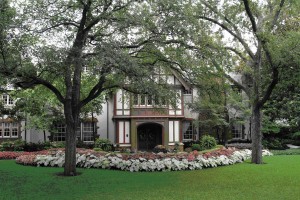
Why Overseed Your Lawn
 As the term suggests, overseeding is spreading grass seed over an existing lawn. There are basically two reasons for overseeding lawns. One is to maintain a healthy, thick lawn, which you do by keeping your grass young, and the other is to avoid an unappealing brown lawn during the winter. With these two different goals there are two slightly different approaches.
As the term suggests, overseeding is spreading grass seed over an existing lawn. There are basically two reasons for overseeding lawns. One is to maintain a healthy, thick lawn, which you do by keeping your grass young, and the other is to avoid an unappealing brown lawn during the winter. With these two different goals there are two slightly different approaches.
Overseeding Warm-Season Grasses with Cool-Season Grass
Because we are in Dallas, Texas our clients’ lawns have warm-season grasses, such as Bermuda grass, buffalo grass, St. Augustine grass or zoysia grass. In the winter when these grasses go dormant, they turn brown and unappealing. By overseeding a lawn with ryegrass, a cool-season annual grass, you can enjoy an attractive green lawn year-round. Another benefit of overseeding your lawn in fall is that it helps reduce weeds, crowding them out naturally, without resorting to chemical weed killers. Importantly, annual ryegrass will die back when the heat returns so that warm-season grasses can take center-stage again. It should be noted, however, that overseeding can also place stress on the primary lawn. In the spring when the warm-season turf is trying to come out of dormancy, the cool-season rye grass is still coming on strong, creating competition and slowing the primary grass growth. Especially in the shade, this can be detrimental for the warm season grass.
Overseeding Cool-Season Grasses with the Same Type of Grass
Not every cool-season grass benefits from overseeding. Grass types that spread by the production of “runners” are not typically overseeded unless the lawn is damaged or diseased. Cool-season bunch type grasses such as fescue grasses, ryegrasses and occasionally bluegrass benefit from overseeding.
The reason to overseed cool-season grasses is to keep your lawn looking thick and healthy. The easiest way to do this is by keeping your grass young. To understand this, it helps to understand a little about how bunch grasses grow. As the name suggests, bunch type grasses grow in a bunch. The grass crown, at the plant’s center, has roots and blades. Grass plants expand as new grass blades or “tillers” develop and grow next to the original crown. A blade of grass has a lifespan of about six weeks and must continually produce new tillers or the grass thins out. Hundreds of new tillers can develop, each having its own crown, roots and blades. After several years, mature plants begin to slow down their reproduction rate. Since new growth must outpace dying grass, it is important to keep young grass in the mix that will produce tillers faster than older grass.
When to Overseed Your Lawn
Whether it’s for warm-season or cool-season grasses, the time to overseed is fall when soil temperatures are still warm (necessary for seed germination), air temperatures are cooler (better for grass growth) and there is more rain. Additionally, cooler temperatures reduce insect infestation and disease.